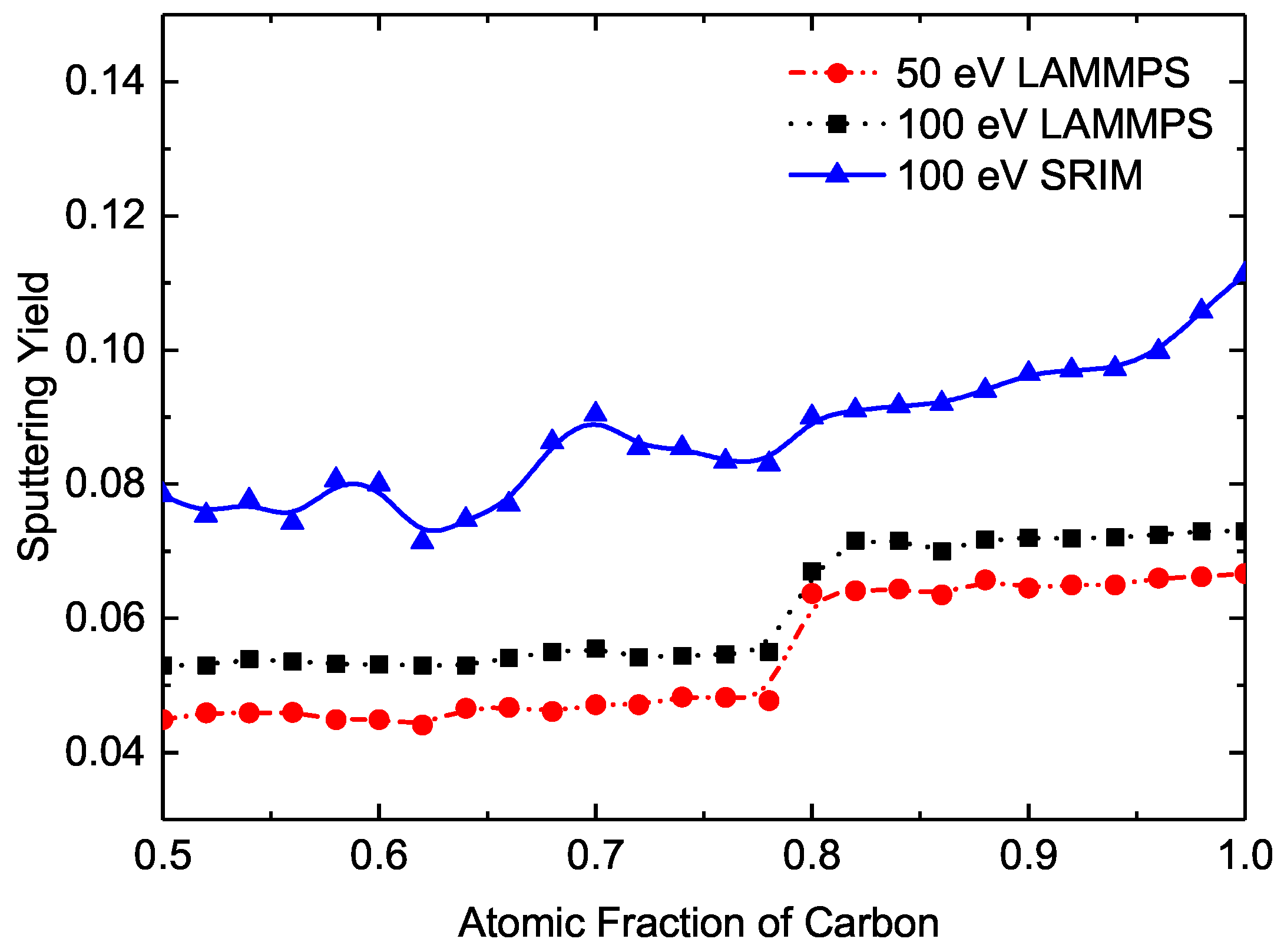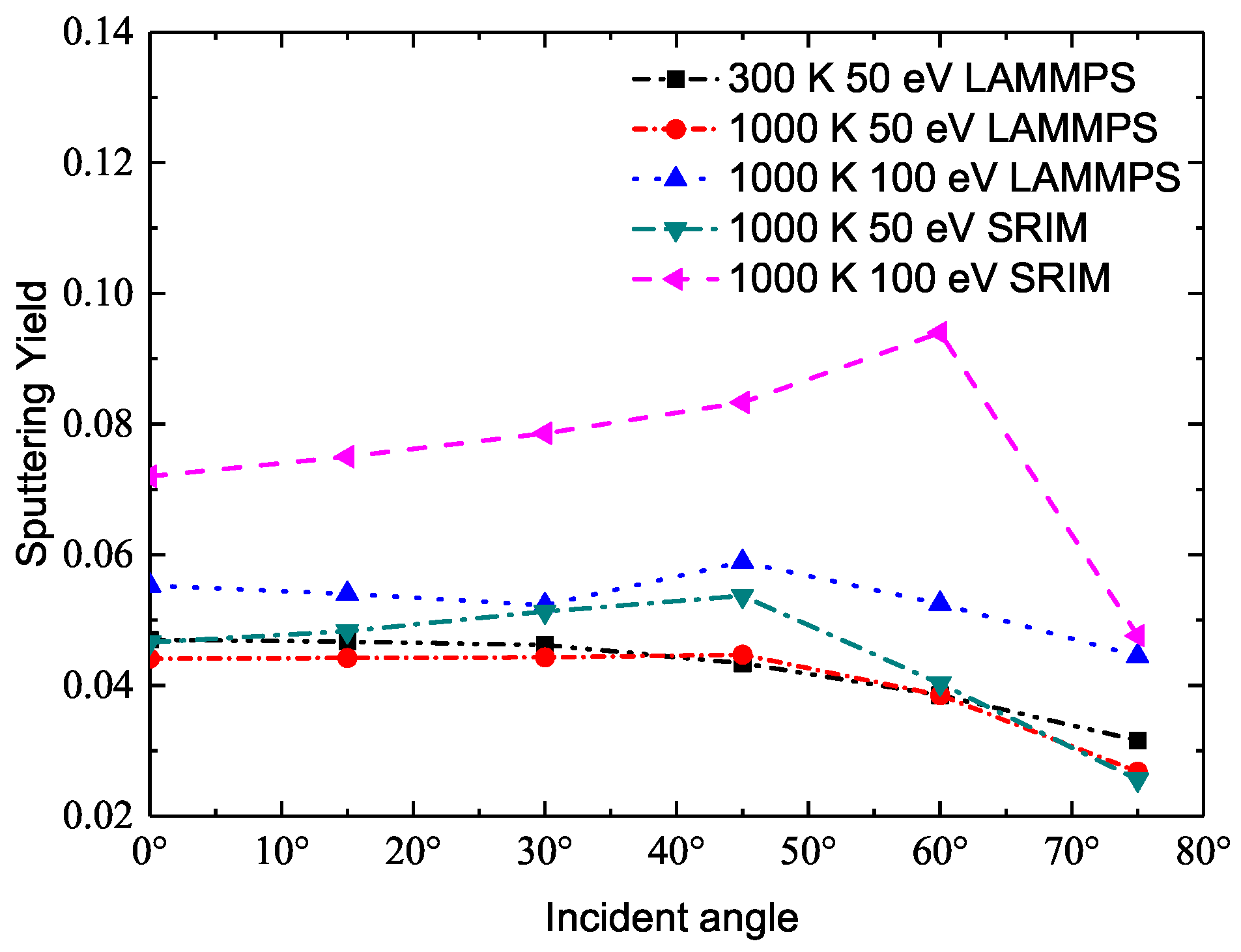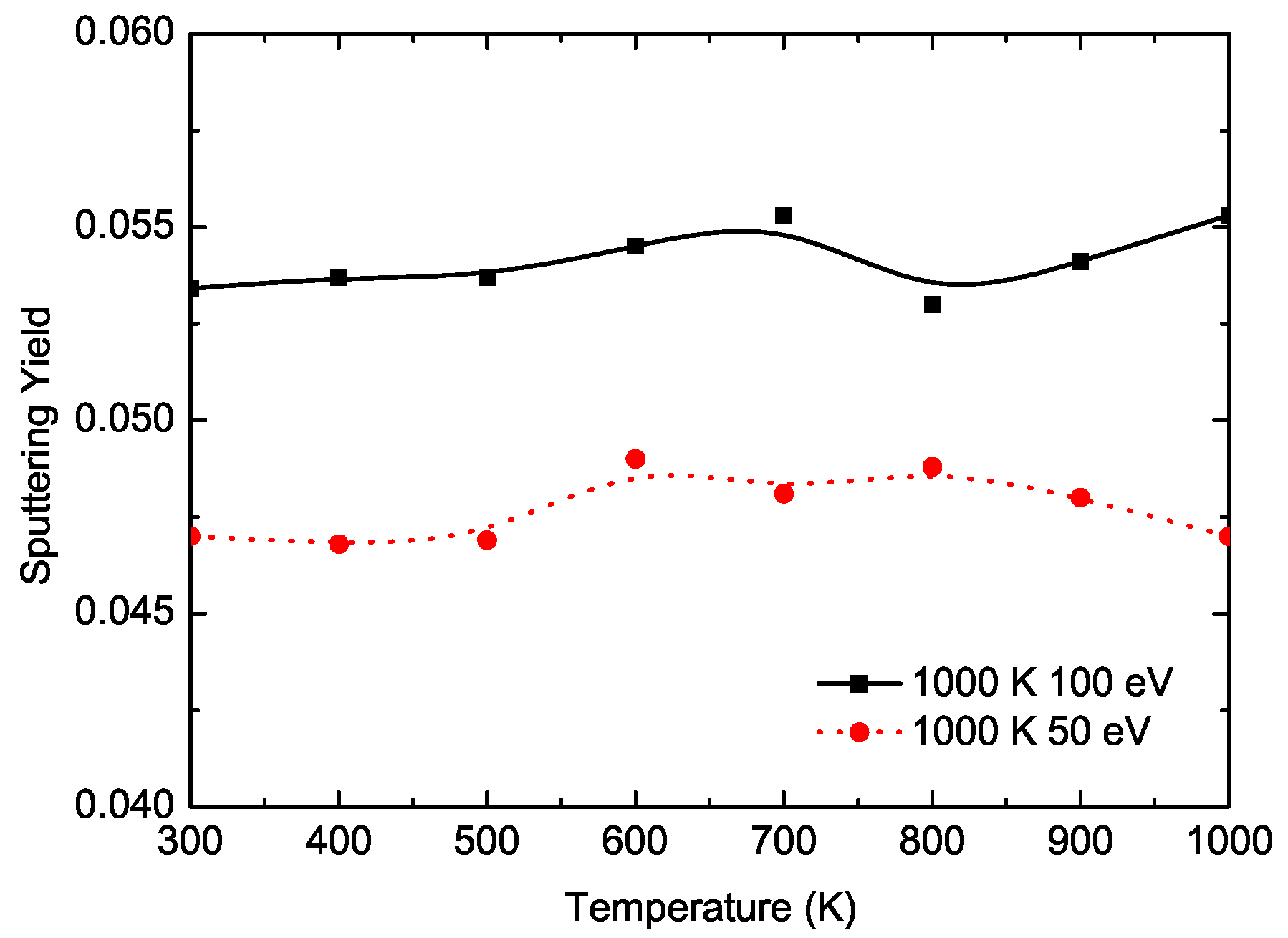Effect of Carbon Concentration on the Sputtering of Carbon-Rich SiC Bombarded by Helium Ions
Abstract
:1. Introduction
2. Models and Computational Details
3. Results and Discussion
3.1. Carbon Concentration Effect
3.2. Energy Effect
3.3. Incident Angle Effect
3.4. Temperature Effect
4. Conclusions
Acknowledgments
Author Contributions
Conflicts of Interest
References
- López-Honorato, E.; Tan, J.; Meadows, P.J.; Marsh, G.; Xiao, P. TRISO coated fuel particles with enhanced SiC properties. J. Nucl. Mater. 2009, 392, 219–224. [Google Scholar] [CrossRef]
- Carpenter, D.; Ahn, K.; Kao, S.P.; Hejzlar, P.; Kazimi, M.S. Assessment of Silicon Carbide Cladding for High Performance Light Water Reactors; Nuclear Fuel Cycle Program (CANES Reports); Massachusetts Institute of Technology: Cambridge, MA, USA, 2007. [Google Scholar]
- Iveković, A.; Novak, S.; Dražić, G.; Blagoeva, D.; de Vicente, S.G. Current status and prospects of SiCf/SiC for fusion structural applications. J. Eur. Ceram. Soc. 2013, 33, 1577–1589. [Google Scholar] [CrossRef]
- Moyer, M. Fusion’s false dawn. Sci. Am. 2010, 302, 50–57. [Google Scholar] [CrossRef] [PubMed]
- Jones, R.H.; Giancarli, L.; Hasegawa, A.; Katoh, Y.; Kohyama, A.; Riccardi, B.; Snead, L.L.; Weber, W.J. Promise and challenges of SiCf/SiC composites for fusion energy applications. J. Nucl. Mater. 2002, 307, 1057–1072. [Google Scholar] [CrossRef]
- Linke, J. High heat flux performance of plasma facing materials and components under service conditions in future fusion reactors. Fusion Sci. Technol. 2012, 61, 246–255. [Google Scholar] [CrossRef]
- Linke, J.; Escourbiac, F.; Mazul, I.V.; Nygren, R.; Rödig, M.; Schlosser, J.; Suzuki, S. High heat flux testing of plasma facing materials and components—Status and perspectives for ITER related activities. J. Nucl. Mater. 2007, 367, 1422–1431. [Google Scholar] [CrossRef]
- Kim, H.S.; Noh, S.J.; Kweon, J.J.; Lee, C.E. Influence of irradiation with low-energy helium ions on graphite and tungsten for fusion applications. J. Korean Phys. Soc. 2013, 63, 1422–1426. [Google Scholar] [CrossRef]
- Causey, R.A. Sputtering and codeposition of silicon carbide with deuterium. J. Nucl. Mater. 2003, 313, 450–454. [Google Scholar]
- Salonen, E.; Nordlund, K.; Keinonen, J.; Wu, C.H. Chemical sputtering of amorphous silicon carbide under hydrogen bombardment. Appl. Surf. Sci. 2001, 184, 387–390. [Google Scholar] [CrossRef]
- Li, M.; Yue, Y. Molecular dynamics study of thermal transport in amorphous silicon carbide thin film. RSC Adv. 2014, 4, 23010–23016. [Google Scholar] [CrossRef]
- Snead, L.L.; Nozawa, T.; Ferraris, M.; Katoh, Y.; Shinavski, R.; Sawan, M. Silicon carbide composites as fusion power reactor structural materials. J. Nucl. Mater. 2011, 417, 330–339. [Google Scholar] [CrossRef]
- Nozawa, T.; Hinoki, T.; Hasegawa, A.; Kohyama, A.; Katoh, Y.; Snead, L.L.; Henager, C.H., Jr.; Hegeman, J.B.J. Recent advances and issues in development of silicon carbide composites for fusion applications. J. Nucl. Mater. 2009, 386, 622–627. [Google Scholar]
- Hinoki, T.; Katoh, Y.; Snead, L.L.; Jung, H.C.; Ozawa, K.; Katsui, H.; Zhong, Z.H.; Kondo, S.; Park, Y.H.; Shih, C.; et al. Silicon carbide and silicon carbide composites for fusion reactor application. Mater. Trans. 2013, 54, 472–476. [Google Scholar] [CrossRef]
- Katoh, Y.; Ozawa, K.; Hinoki, T.; Choi, Y.; Snead, L.L.; Hasegawa, A. Mechanical properties of advanced SiC fiber composites irradiated at very high temperatures. J. Nucl. Mater. 2011, 417, 416–420. [Google Scholar] [CrossRef]
- Hegeman, J.B.J.; Van der Laan, J.G.; Van Kranenburg, M.; Jong, M.; d’Hulst, D.; Ten Pierick, P. Mechanical and thermal properties of SiCf/SiC composites irradiated with neutrons at high temperatures. Fusion Eng. Des. 2005, 75, 789–793. [Google Scholar] [CrossRef]
- Shikama, T.; Fujitsuka, M.; Araki, H.; Noda, T.; Tanabe, T.; Shinno, H. Irradiation behavior of carbon-boron compounds and silicon carbide composites developed as fusion reactor materials. J. Nucl. Mater. 1992, 191, 611–615. [Google Scholar] [CrossRef]
- Rieth, M.; Dudarev, S.L.; De Vicente, S.G.; Aktaa, J.; Ahlgren, T.; Antusch, S.; Armstrong, D.E.J.; Balden, M.; Baluc, N.; Barthe, M.F.; et al. Recent progress in research on tungsten materials for nuclear fusion applications in Europe. J. Nucl. Mater. 2013, 432, 482–500. [Google Scholar] [CrossRef]
- Philipps, V. Tungsten as material for plasma-facing components in fusion devices. J. Nucl. Mater. 2011, 415, S2–S9. [Google Scholar] [CrossRef]
- Katoh, Y.; Snead, L.L.; Szlufarska, I.; Weber, W.J. Radiation effects in SiC for nuclear structural applications. Curr. Opin. Solid State Mater. Sci. 2012, 16, 143–152. [Google Scholar] [CrossRef]
- Nakamura, H.; Shu, W.; Hayashi, T.; Nishi, M. Tritium permeation study through tungsten and nickel using pure tritium ion beam. J. Nucl. Mater. 2003, 313, 679–684. [Google Scholar] [CrossRef]
- Nakamura, H.; Hayashi, T.; Kakuta, T.; Suzuki, T.; Nishi, M. Tritium permeation behavior implanted into pure tungsten and its isotope effect. J. Nucl. Mater. 2001, 297, 285–291. [Google Scholar] [CrossRef]
- Causey, R.A.; Wampler, W.R. The use of silicon carbide as a tritium permeation barrier. J. Nucl. Mater. 1995, 220, 823–826. [Google Scholar] [CrossRef]
- Wright, G.M.; Durrett, M.G.; Hoover, K.W.; Kesler, L.A.; Whyte, D.G. Silicon Carbide as a tritium permeation barrier in tungsten plasma-facing components. J. Nucl. Mater. 2015, 458, 272–274. [Google Scholar] [CrossRef]
- Causey, R.A.; Garde, J.M.; Buchenauer, D.A.; Calderoni, P.; Holschuh Jr, T.; Youchison, D.L.; Wright, M.; Kolasinski, R.D. Silicon Carbide Tritium Permeation Barrier for Steel Structural Components; Sandia National Laboratories: Livermore, CA, USA, 2010. [Google Scholar]
- Pramono, Y.; Sasaki, K.; Yano, T. Release and diffusion rate of helium in neutron-irradiated SiC. J. Nucl. Sci. Technol. 2004, 41, 751–755. [Google Scholar] [CrossRef]
- Lewinsohn, C.A.; Youngblood, G.E.; Henager Jr, C.H.; Simonen, E.P.; Jones, R.H. Time-dependent failure mechanisms in silicon carbide composites for fusion energy applications. J. Nucl. Mater. 2000, 283, 584–587. [Google Scholar] [CrossRef]
- Raffray, A.R.; El-Guebaly, L.; Gordeev, S.; Malang, S.; Mogahed, E.; Najmabadi, F.; Sviatoslavsky, I.; Sze, D.K.; Tillack, M.S.; Wang, X.; et al. High performance blanket for ARIES-AT power plant. Fusion Eng. Des. 2001, 58, 549–553. [Google Scholar] [CrossRef]
- Raffray, A.R.; El-Guebaly, L.; Malang, S.; Sviatoslavsky, I.; Tillack, M.S.; Wang, X.; ARIES Team. Advanced power core system for the ARIES-AT power plant. Fusion Eng. Des. 2006, 80, 79–98. [Google Scholar] [CrossRef]
- Seki, Y.; Mori, S.; Nishio, S.; Ueda, S.; Kurihara, R. Neutron Streaming Evaluation for the DREAM Fusion Power Reactor. J. Nucl. Sci. Technol. 2000, 37, 268–275. [Google Scholar] [CrossRef]
- Kikuchi, H.; Kalia, R.K.; Nakano, A.; Vashishta, P.; Branicio, P.S.; Shimojo, F. Brittle dynamic fracture of crystalline cubic silicon carbide (3C-SiC) via molecular dynamics simulation. J. Appl. Phys. 2005, 98, 103524. [Google Scholar] [CrossRef]
- Nakano, K.; Kamiya, A.; Ogawa, H.; Nishino, Y. Fabrication and mechanical properties of carbon fiber reinforced silicon carbide composites. J. Ceram. Soc. Jpn. 1992, 100, 472–475. [Google Scholar] [CrossRef]
- Xu, Y.; Zhang, Y.; Cheng, L.; Zhang, L.; Lou, J.; Zhang, J. Preparation and friction behavior of carbon fiber reinforced silicon carbide matrix composites. Ceram. Int. 2007, 33, 439–445. [Google Scholar] [CrossRef]
- Mei, H.; Cheng, L.; Ke, Q.; Zhang, L. High-temperature tensile properties and oxidation behavior of carbon fiber reinforced silicon carbide bolts in a simulated re-entry environment. Carbon 2010, 48, 3007–3013. [Google Scholar] [CrossRef]
- Wang, Y.; Wu, H. Microstructure of friction surface developed on carbon fibre reinforced carbon–silicon carbide (Cf/C–SiC). J. Eur. Ceram. Soc. 2012, 32, 3509–3519. [Google Scholar] [CrossRef] [Green Version]
- Zhang, Q.; Cheng, L.; Zhang, L.; Xu, Y. Thermal expansion behavior of carbon fiber reinforced chemical-vapor-infiltrated silicon carbide composites from room temperature to 1400 °C. Mater. Lett. 2006, 60, 3245–3247. [Google Scholar] [CrossRef]
- Xu, H.; Zhang, L.; Wang, Y.; Cheng, L. The effects of Z-stitching density on thermophysical properties of plain woven carbon fiber reinforced silicon carbide composites. Ceram. Int. 2015, 41, 283–290. [Google Scholar] [CrossRef]
- Berbon, M.Z.; Dietrich, D.R.; Marshall, D.B.; Hasselman, D.P.H. Transverse thermal conductivity of thin C/SiC composites fabricated by slurry infiltration and pyrolysis. J. Am. Ceram. Soc. 2001, 84, 2229–2234. [Google Scholar] [CrossRef]
- Chen, S.; Feng, Y.; Qin, M.; Ji, T.; Feng, W. Improving thermal conductivity in the through-thickness direction of carbon fibre/SiC composites by growing vertically aligned carbon nanotubes. Carbon 2017, 116, 84–93. [Google Scholar] [CrossRef]
- Roth, J.; Bohdansky, J.; Poschenrieder, W.; Sinha, M.K. Physical and chemical sputtering of graphite and SiC by hydrogen and helium in the energy range of 600 to 7500 eV. J. Nucl. Mater. 1976, 63, 222–229. [Google Scholar] [CrossRef]
- Mutzke, A.; Bandelow, G.; Schneider, R. Sputtering of mixed materials of beryllium and tungsten by hydrogen and helium. J. Nucl. Mater. 2015, 467, 413–417. [Google Scholar] [CrossRef]
- Gamero-Castaño, M.; Mahadevan, M. Sputtering yields of Si, SiC, and B4C under nanodroplet bombardment at normal incidence. J. Appl. Phys. 2009, 106, 054305. [Google Scholar] [CrossRef]
- Ziebert, C.; Ye, J.; Ulrich, S.; Prskalo, A.P.; Schmauder, S. Sputter Deposition of Nanocrystalline β-SiC Films and Molecular Dynamics Simulations of the Sputter Process. J. Nanosci. Nanotechnol. 2010, 10, 1120–1128. [Google Scholar] [CrossRef] [PubMed]
- Borrajo-Pelaez, R.; Grustan-Gutierrez, E.; Gamero-Castaño, M. Sputtering of Si, SiC, InAs, InP, Ge, GaAs, GaSb, and GaN by electrosprayed nanodroplets. J. Appl. Phys. 2013, 114, 184304. [Google Scholar] [CrossRef]
- Shih, C.; Katoh, Y.; Steinbeck, J. Effect of Neutron Irradiation on Carbon Fiber Reinforced SiC Matrix Composites. Trans. Am. Nucl. Soc. 2012, 107, 403–404. [Google Scholar]
- Shih, C.; Katoh, Y.; Snead, L.L.; Steinbeck, J. The effect of neutron irradiation on the mechanical properties of C/SiC composites. J. Nucl. Mater. 2013, 439, 192–201. [Google Scholar] [CrossRef]
- Sone, K.; Saidoh, M.; Nakamura, K.; Yamada, R.; Murakami, Y.; Shikama, T.; Fukutomi, M.; Kitajima, M.; Okada, M. Sputtering of silicon carbide coatings by low-energy hydrogen ions. J. Nucl. Mater. 1981, 98, 270–278. [Google Scholar] [CrossRef]
- Salonen, E.; Nordlund, K.; Keinonen, J.; Runeberg, N.; Wu, C.H. Reduced chemical sputtering of carbon by silicon doping. J. Appl. Phys. 2002, 92, 2216–2218. [Google Scholar] [CrossRef]
- Zhao, Q.; Zhang, Z.; Li, Y.; Ouyang, X. The mechanical and thermodynamic properties of β-Si1−xC. RSC Adv. 2017, 7, 28499–28505. [Google Scholar] [CrossRef]
- Plimpton, S. Fast parallel algorithms for short-range molecular dynamics. J. Comp. Phys. 1995, 117, 1–19. [Google Scholar] [CrossRef]
- Peng, P.; Liao, G.; Shi, T.; Tang, Z.; Gao, Y. Molecular dynamic simulations of nanoindentation in aluminum thin film on silicon substrate. Appl. Surf. Sci. 2010, 256, 6284–6290. [Google Scholar] [CrossRef]
- Sun, L.; Lan, C.; Zhao, S.; Xue, J.; Wang, Y. Self-irradiation of thin SiC nanowires with low-energy ions: A molecular dynamics study. J. Phys. D 2012, 45, 135403. [Google Scholar] [CrossRef]
- Jin, E.; Du, S.; Li, M.; Liu, C.; He, S.; He, J.; He, H. Influence of helium atoms on the shear behavior of the fiber/matrix interphase of SiC/SiC composite. J. Nucl. Mater. 2016, 479, 504–514. [Google Scholar] [CrossRef]
- Ziegler, J.F.; Ziegler, M.D.; Biersack, J.P. SRIM—The stopping and range of ions in matter. Nucl. Instr. Methods Phys. Res. Sect. B 2010, 268, 1818–1823. [Google Scholar] [CrossRef]





© 2018 by the authors. Licensee MDPI, Basel, Switzerland. This article is an open access article distributed under the terms and conditions of the Creative Commons Attribution (CC BY) license (http://creativecommons.org/licenses/by/4.0/).
Share and Cite
Liang, X.; Li, Y.; Zhao, Q.; Zhang, Z.; Ouyang, X. Effect of Carbon Concentration on the Sputtering of Carbon-Rich SiC Bombarded by Helium Ions. Computation 2018, 6, 19. https://doi.org/10.3390/computation6010019
Liang X, Li Y, Zhao Q, Zhang Z, Ouyang X. Effect of Carbon Concentration on the Sputtering of Carbon-Rich SiC Bombarded by Helium Ions. Computation. 2018; 6(1):19. https://doi.org/10.3390/computation6010019
Chicago/Turabian StyleLiang, Xinghao, Yang Li, Qiang Zhao, Zheng Zhang, and Xiaoping Ouyang. 2018. "Effect of Carbon Concentration on the Sputtering of Carbon-Rich SiC Bombarded by Helium Ions" Computation 6, no. 1: 19. https://doi.org/10.3390/computation6010019




